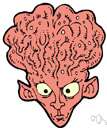mac·ro·ceph·a·ly
(măk′rō-sĕf′ə-lē) also mac·ro·ce·pha·li·a (-sə-fā′lē-ə, -fāl′yə)n.
Abnormal largeness of the head. Also called megacephaly, megalocephaly.
mac′ro·ce·phal′ic (-sə-făl′ĭk), mac′ro·ceph′a·lous adj.
American Heritage® Dictionary of the English Language, Fifth Edition. Copyright © 2016 by Houghton Mifflin Harcourt Publishing Company. Published by Houghton Mifflin Harcourt Publishing Company. All rights reserved.
macrocephaly
(ˌmækrəʊˈsɛfəlɪ) or less commonlymacrocephalia
n
(Pathology) the condition of having an abnormally large head or skull
macrocephalic, ˌmacroˈcephalous adj
Collins English Dictionary – Complete and Unabridged, 12th Edition 2014 © HarperCollins Publishers 1991, 1994, 1998, 2000, 2003, 2006, 2007, 2009, 2011, 2014
mac•ro•ceph•a•ly
(ˌmæk roʊˈsɛf ə li)n.
disproportionate largeness of the skull or head.
[1885–90]
mac`ro•ce•phal′ic (-səˈfæl ɪk) adj.
Random House Kernerman Webster's College Dictionary, © 2010 K Dictionaries Ltd. Copyright 2005, 1997, 1991 by Random House, Inc. All rights reserved.
macrocephalism, macrocephaly
a condition in which the head or cranial capacity is unusually large. — macrocephalic, macrocephalous, adj.
See also: Head-Ologies & -Isms. Copyright 2008 The Gale Group, Inc. All rights reserved.
ThesaurusAntonymsRelated WordsSynonymsLegend:
| Noun | 1. |  macrocephaly - an abnormally large head; differs from hydrocephalus because there is no increased intracranial pressure and the overgrowth is symmetrical macrocephaly - an abnormally large head; differs from hydrocephalus because there is no increased intracranial pressure and the overgrowth is symmetricalabnormalcy, abnormality - an abnormal physical condition resulting from defective genes or developmental deficiencies |
Based on WordNet 3.0, Farlex clipart collection. © 2003-2012 Princeton University, Farlex Inc.